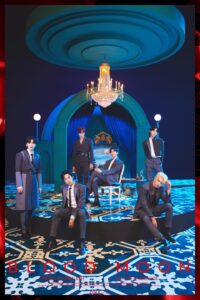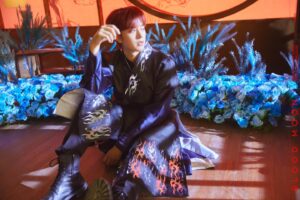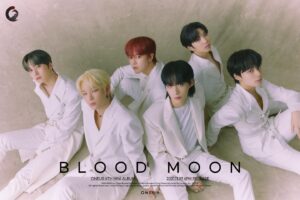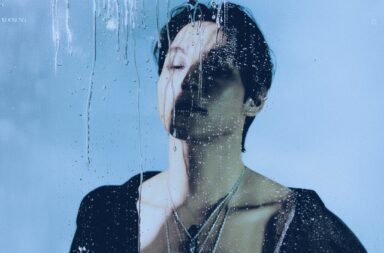
On the night of a fated blood moon, six demons emerge in search of a lost beloved. Forbidden from death, the six continue to search for someone to accept their heart and grow increasingly feral as the centuries pass by. Soon, they come across a pure white flower that blooms only once a year. In brilliant white and fragrant from a distance, the flower greets their shapes lit only by the light of the foreboding red moon.
The introduction to Oneus’s Blood Moon, “Intro: Window,” highlights a stunning contradiction between dark omens associated with blood moons and eclipses, and fateful good omens of the Epiphyllum oxypetalum, or Lady of the Night flower. Blood moons are typically associated with misfortune and danger. They have been described as a “rip in the fabric of order” in the universe, leading 16th century indigenous Aztecs to hide away childbearing women out of fear. It comes as no surprise then that the night of a rare lunar eclipse is when Oneus appear into the world of the living.
The latter imagery centers around a strange cactus flower that only blooms once a year, the Queen of the Night or Night-blooming Cereus. It blooms only one night every year, all at once as a species, and then withers away as the sun rises. Because of its elusive, unpredictable nature, the flower is thought to bring good luck and prosperity.
The lyrics describe “a Venus in the moonlight” and “a flower blooming alone” under the starless sky. While the flowers do often bloom simultaneously, Oneus here describe a Lady of the Night displaced from its sistren, blooming alone, forgotten, and unexpectedly. Frustrated, the members yearn to “let the frustration in [their] hearts out of [a] window.” The windows they speak of are also metaphorical, as well as literal. They are sometimes seen as portals or openings that represent new opportunities, illusions, or simultaneity. The members are letting their frustrations escape out of the window in order to become free and rid themselves of negative (potentially dangerous) energy. It may be all for naught though if Hwanwoong’s ending pose hanging upside down menacingly like a bat is any indication.
Adding to the imagery, the music includes a remarkable fusion of pansori and rapping. Featuring Choi Ye Lim, the introduction begins with a haunting verse describing the immortal demon protagonists. As the words “they appear” hang in the air, the timbre of the song morphs into a spitfire hip hop tune pulsing with electrified bass and Leedo’s low tone rapping. While the flower and window remain central themes, the demons and their aggression are the focus for “Intro: Window.”

The title track “LUNA” (or 월하미인, the name of the flower in Korean) furthers the story from the intro, but focuses on the delicate grace of the Lady of the Night flower. Seoho and Xion’s opening verse sets the scene: “a pitch-black night, the lone cry of the moon,” where they lay “waiting without knowing” when their love might return. The chorus describes the feeling of being in love “just like the blinding light that blossomed at the darkest of the night” and “like the flower that blossomed to show its love to the moonlight.” Much like the flower, their love seems to have burned brightly, before suddenly withering away, and being doomed to wander alone, a victim of their immortal fate.
The music sports a similar fusion of traditional elements and Oneus’ characteristic, cinematic dance/hip hop sound. The overall flow of the song is lilting and contemplative, even the lyrical raps from Ravn and Leedo, with a stronger transition that acts as a dance break in the latter half of the song. It finally reaches a climax in the last chorus and outro, combining many of the previous themes and adding pansori ad-libs over it.
One of the most captivating aspects of “Luna,” aside from the music itself, is the choreography. I often appreciate the level of detail and storytelling that Oneus convey through their choreography, but the addition of paper fans is enthralling. Not only is it eye-catching and evocative, but the sound of the fans opening adds a layer of allure that might catch one by surprise. This effect is somewhat lost in the MV because of the way the sound is added in post, but is certainly not lost in their live performances. Their showcase performance has remarkably (seemingly) live mics and the fans are loud, adding a resounding punctuation to phrases.
The two most similar songs to the title track are “Yes or No” and “We’re In Love.” It seems Oneus have found their beloved and plan to move forward in their romance. “Yes or No” is sexy and upbeat. Like the opposite polarities of a magnet, the lyrics and sound flirt with the idea of an all-or-nothing romance. Even if the fire goes out, they express a desire to love brightly and brilliantly, almost dangerously so. The vocals and lively electric drum kit are most prevalent with a nice mix of brass and synthesizer lines to add to the melodic texture. The raps take on a sultrier, in-your-face sound while the vocals demonstrate remarkable range and prowess, especially from Keonhee and Seoho.

“We’re In Love” is the antithesis to “Yes or No.” Oneus encourages the listener to take a deep breath, slow down, and find comfort in a budding romance. The texture is less busy and instead more pop sounding and comforting. The auxiliary sounds and midi tracks fill out the remainder of the soundscape around the fun vocals. It makes for a chiller, comfortable opposite to the urgency of “Yes or No.”
The three remaining tracks are the most polarizing musically and thematically. “Life is Beautiful” is a summer song, like the feeling of dancing across the beach with friends, free of worry. “Who You Are” is sensual and sassy with a sexy gravity that lures in the listener, while “Shut Up Badgo (받고) Crazy Hot!” is a loud, hubris-soaked, angry song revived and remixed from their pre-debut days.
“Life is Beautiful” is uplifting and witty. Backdropped by the ocean and clear blue skies, the MV (part of the Oneus Theatre series) shows the members frolicking along a beachfront and a brightly lit school gym. The choreography and cinematography are fresh, capitalizing on how pretty both the setting and members are. The addition of the flute in both the chorus and some verses adds a nice, almost tropical touch to the sound. Throughout the song, the members encourage listeners to go at their own pace and that slowing down to take a breath is alright, “even when things don’t turn out the way you want.”

The last song on the tracklist, “Who You Are,” stands out from the rest of the songs on the album. Encouraging listeners to “swipe up,” the members tell of a love story on the fringes of lust. Though Oneus and their lover know each other well, Oneus encourage them to give in to their desires and spill all their secrets, bodily and otherwise. The sound of the song is smooth with mostly mid-range vocals and R&B-influenced instrumentals. When the members do flip up into their falsetto, it creates a nice contrast from their more intimate, almost whispered verses.
The loudest, angriest song on the album is “Shut Up Badgo (받고) Crazy Hot!.” Originally a pre-debut collaboration with Onewe, it is an electric guitar and driving, piano-laden romp in the desert. Another addition to Oneus’ ongoing Oneus Theatre series, the MV shows the members in leather and chains dancing powerfully with their somewhat zombified backup dancers. Ripped clothes, fire, faux guns, and branded flags all mark the members as chaotic rogues eager to get a party started and live in the moment.
The complexity of the song is actually pretty interesting. Aside from the loud pyrotechnics and fiery gang vocals, the piano and guitar riff that begins the whole song ultimately gets passed around, deconstructed, and reformed in a bunch of different sections and instrumentations, creating a nice continuity from beginning to end. It might be a small detail, but it adds to the continued high level of detail and intentionality in the songwriting for the group.

While overall some of the songs do not seem to fit the aesthetic of the album, the introduction emphasizes contrast, opposites, and polarizing forces to bring the tracklist together nicely. Each song is wildly different, nuanced, and well written, with high levels of detail to uncover as one listens closely. For now, it seems hard to pinpoint exactly where Oneus’ album lore is leading after Blood Moon, but there is no denying that they remain the kings of riotous performances and remarkably nuanced fusions between traditional and modern elements.
(This is Tucson, The New York Times, Awkward Botany, Slap Happy Larry, Cultural Heritage Administration, YouTube [1][2][3], Images via RBW Entertainment)


